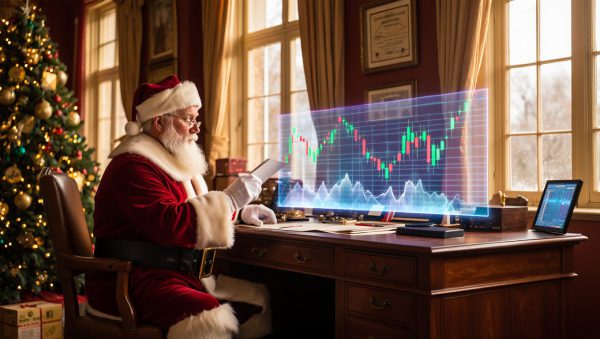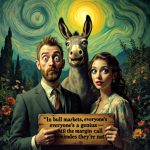
The Santa Claus Rally Trap: How Fear and Herd Mentality Blind Investors to Opportunity
Apr 15, 2025
Warning: The stock market is a battlefield, and few things expose its contradictions like the so-called “Santa Claus Rally.” As December drifts into January, the market moves, traders jostle, and the herd follows blindly, clutching at seasonal patterns as if they are guarantees. But here’s the danger—the obsession with Santa Claus rally dates isn’t an edge. It’s a trap. The fear of missing out, the collective panic when the rally doesn’t materialize, and the blind faith in historical trends are what destroy portfolios. Survival demands precision, not superstition.
The Santa Claus rally phenomenon isn’t just a quirk of the calendar. It’s the perfect mirror of market psychology: greed disguised as optimism, fear buried beneath festive euphoria. For those who see beyond the surface, it’s an opportunity to exploit the inefficiencies of the herd. But what about the unprepared? It’s a storm that will wipe them out before the new year even begins.
Exposing Market Panic: Why the Herd Always Loses
Market panic isn’t a bug—it’s a feature. The financial markets thrive on emotion, and nothing triggers irrationality like fear. Investors cling to patterns, desperate for a sense of control, and the Santa Claus rally is one of the most seductive. After all, who wouldn’t want to believe in a magical end-of-year surge? But here’s the truth: belief in the rally is often rooted in fear, not logic. It’s the fear of being left behind, the fear of missing out on a rare seasonal gain.
The problem? Fear blinds. When traders pile into the market in late December, chasing Santa Claus rally dates, they’re often ignoring the fundamentals. Behavioral finance explains this perfectly: cognitive biases like anchoring and confirmation bias trap investors into seeing patterns where none exist. Add the herd mentality—where every investor amplifies the actions of the next—and you have a recipe for disaster.
Consider the 2018 end-of-year selloff. The “Santa Claus Rally” failed to appear, and instead of euphoria, chaos reigned. The S&P 500 dropped nearly 10% in December, wiping out billions. Investors who chased the rally were left holding the bag, while the contrarians—those who acted against the crowd—profited from the carnage. This is the lesson of market panic: the herd may promise safety, but it always delivers destruction.
The Wolves Move Different: Contrarian Mastery in Action
While the herd drowns in its own fear, the wolves—the contrarians, the bold, the few—thrive. They understand that market anomalies, like the Santa Claus rally, aren’t guaranteed windfalls. They’re opportunities to exploit inefficiencies, to profit from the irrationality of others.
Take Jesse Livermore, the legendary trader who built and lost fortunes by mastering market psychology. Livermore didn’t chase trends—he anticipated them. He understood that fear and greed drive markets, and he used that knowledge to strike when others hesitated. The same principles apply to Santa Claus rally dates. The contrarians don’t blindly buy into the rally—they analyze the conditions that make it possible. Is sentiment overly bullish? Are valuations stretched? Is there an opportunity to short the market instead of going long?
Modern contrarians like Ray Dalio take a similar approach. Dalio’s “Principles” emphasize systems thinking—seeing the market as a complex system of interrelated parts. For the wolves, Santa Claus rally dates are just one piece of the puzzle. They see beyond the calendar, beyond the noise, and into the underlying dynamics of the market. And when they strike, they do so with precision, turning the herd’s blind faith into their own advantage.
Fear as Fuel: The Power of Strategic Options Plays
Fear isn’t just a liability—it’s fuel. In volatile markets, fear creates inefficiencies, and smart traders know how to exploit them. One of the most powerful strategies? Selling put options during periods of heightened volatility. When traders panic, options premiums spike, creating opportunities for those willing to take calculated risks.
Here’s how it works: sentiment often shifts wildly as Santa Claus rally dates approach. If the rally fails to materialize, volatility increases as the herd capitulates. The contrarians step in, selling puts to collect inflated premiums. This isn’t reckless gambling—it’s a disciplined play, grounded in a deep understanding of market mechanics.
But the real magic happens next: The premiums collected from selling puts can be reinvested into LEAPS (Long-Term Equity Anticipation Securities). These long-dated options offer leveraged exposure to future upside, allowing traders to profit from both short-term fear and long-term growth. It’s a strategy that turns chaos into control, using the market’s own irrationality as a weapon.
Think of it as alchemy: transforming the raw energy of fear into a structured, high-probability trade. This is how the wolves operate. They don’t just survive the chaos—they thrive in it, using fear as the foundation for calculated aggression.
Disciplined Boldness: The Art of Calculated Aggression
Boldness without discipline is recklessness. Discipline without boldness is paralysis. The wolves understand this balance, and they walk the line with precision. Every trade is a calculated risk, every move grounded in meticulous planning and analysis.
When it comes to Santa Claus rally dates, disciplined boldness means knowing when to act—and when to wait. The contrarians don’t chase the rally blindly. They analyze the data, the sentiment, and the broader economic context. They understand that the rally, while historically reliable, is not a certainty. And they prepare for all outcomes, using tools like the VIX, momentum indicators, and yes, even the stochastic oscillator, to guide their decisions.
This is the difference between the wolves and the herd: the herd reacts; the wolves anticipate. The herd chases; the wolves position. The herd panics; the wolves exploit. And in the end, it’s the wolves who emerge victorious, while the herd is left wondering what went wrong.
The Exit Velocity of Independence
At its core, trading isn’t just about money—it’s about independence. It’s about escaping the mental prison of the herd, breaking free from the fear and conformity that dominate the markets. Santa Claus rally dates are a perfect metaphor for this struggle: a symbol of the herd’s blind optimism, and an opportunity for the bold to rise above it.
When you understand the dynamics behind the rally, you gain more than an edge—you gain clarity. You see the market for what it truly is: a battlefield of emotion and contradiction, where fear and greed collide to create opportunity. And most importantly, you learn to trust yourself. To act decisively when others hesitate. To hold steady when others panic. To escape the noise and focus on what truly matters.
This is the ultimate paradox: independence requires discipline. Freedom demands restraint. To escape the herd, you must first master yourself. And when you do, the market ceases to be a source of fear—it becomes a source of power.
So, as the next Santa Claus rally approaches, ask yourself: will you follow the herd, or will you rise above it? Will you chase the rally, or will you position yourself to profit from the chaos it creates? The choice is yours. But remember this: in the markets, as in life, the bold always win.












